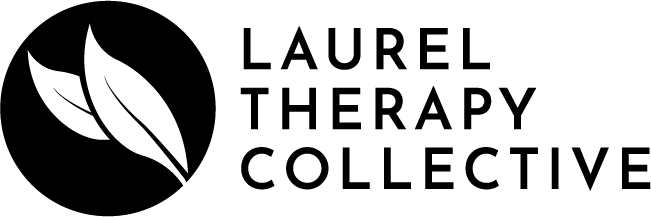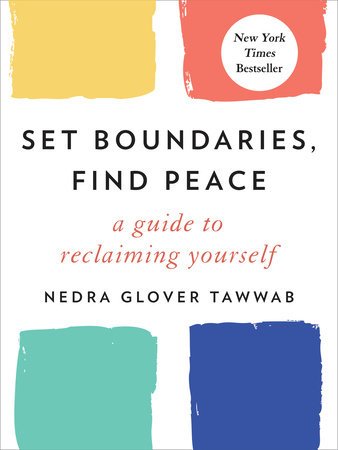Therapeutic Book Review: Set Boundaries, Find Peace by Nedra Tawwab
Nedra Tawwab's "Set Boundaries, Find Peace" is a fabulous book. It has an overall tone of empowerment and permission to honor your own needs. She uses real-life examples from her therapy patients to explore how setting boundaries improved their lives. It's filled with how-tos for handling challenges in relationships. While Tawwab navigates the landscape of boundaries with confidence, a few topics are left unexplored. Here is our honest review, including sections we wish she'd included.
The Strengths of "Set Boundaries, Find Peace"
Tawwab’s book is a breath of fresh air in the crowded field of self-help literature. She uses her experience as a therapist to provide a roadmap for people seeking to establish and maintain boundaries and make their relationships healthier. She tells specific stories about clients that keep you engaged, and explores different types of boundaries, breaking them down into categories. She gives examples of what to say and addresses common concerns about setting boundaries.
About the reviewer: Laurel van der Toorn, LMFT
Laurel is a licensed therapist seeing clients online in California, Colorado, Florida, Michigan, and Washington. She empowers her clients to set healthy boundaries with work, family, friends, and themselves.
Types of Boundaries Explored in Set Boundaries, Find Peace
One of the standout features of Tawwab's work is her exploration of various boundary types. From personal space to emotional boundaries that protect our energy, Tawwab covers a lot. Here's a brief look at some of the categories she covers:
Physical Boundaries
These involve setting limits on physical touch or personal space, asserting control over one's body autonomy. This may seem basic, but in our culture it isn’t always.
Emotional Boundaries
Tawwab tackles the intricacies of emotional boundaries, explaining the importance of safeguarding one's emotions. This includes setting limits with listening to people vent or complain, as well as the common experience of taking ownership of tasks and caregiving that are not your responsibility.
Material Boundaries
Exploring sharing and respecting personal possessions, Tawwab provides guidance on establishing limits in material exchanges. She also explores financial boundaries, both in relationships and within ourselves.
Time Boundaries
Time is our most precious resource. Tawwab explores how to set limits on time commitments, avoiding burnout and promoting balance.
Why We Hesitate to Set Boundaries
There are many emotions and fears that prevent us from setting boundaries. The journey to establish limits is not always straightforward. Tawwab sheds light on the reasons people might hesitate to assert their needs.
Fear of Disapproval Of Our Boundaries
One of the most common reasons people don't set boundaries is the fear of being disliked. In a world where social connection is highly valued, the fear of alienating others can be a powerful deterrent. Tawwab skillfully breaks down this fear, emphasizing that prioritizing one's well-being doesn't equate to being unlikable. It's a step towards more genuine connections based on mutual respect.
Guilt as a Hindrance To Our Boundaries
Tawwab acknowledges that feelings of guilt often accompany setting boundaries. Whether it's declining an invitation, expressing a differing opinion, or asserting personal space, guilt can feel overwhelming. Drawing from real examples, Tawwab unpacks the misconception that prioritizing oneself is selfish. She guides readers through the process of reframing guilt and recognizing its roots. While people may always feel guilt, she encourages readers to get used to the discomfort. For most, guilt is more comfortable than having their boundaries crossed.
The Fear of Our Boundaries Being Hurtful
Tawwab addresses the notion that setting boundaries is mean. The fear of hurting others, intentionally or unintentionally, can be paralyzing. Through anecdotes, Tawwab shows that boundaries are a necessary part of healthy relationships. By reframing boundaries as a form of self-care and not an attack on others, she helps readers find a middle ground between assertiveness and kindness.
The Burden of Perfectionism
Perfectionism, as Tawwab notes, often intertwines with the struggle to set boundaries. The fear of not meeting others' expectations or of being perceived as imperfect can be stifling. Tawwab guides readers to welcome the imperfections inherent in boundary-setting. The goal is not flawlessness, but authenticity.
The Power Dynamics at Play: Balancing Authority and Harmony
Examining power dynamics, Tawwab addresses the fear of disrupting harmony within relationships. Whether it's with family, friends, or colleagues, the fear of upsetting the balance can lead people to avoid setting boundaries altogether. Tawwab offers insights into navigating these power dynamics. Whether it's an elder, a boss, or a community member, boundaries are an essential part of all relationships.
Understanding What Boundaries Actually Are
Tawwab's exploration of the fears surrounding boundary-setting isn't a critique. It's a guide through the barriers we all have. By dissecting these fears, Tawwab empowers readers to confront them effectively.
Readers are encouraged to recognize that these fears are not insurmountable. They're natural aspects of the human experience. Setting boundaries is not about eradicating these fears entirely but learning to coexist with them. We can acknowledge their presence, and still taking steps towards personal growth.
Upholding Boundaries: The Critical Ingredient To Good Boundaries
Tawwab spends plenty of time explaining that the act of setting boundaries is only as powerful as our commitment to upholding them. Establishing boundaries is an ongoing practice that requires consistency.
The Hollow Victory of Setting Boundaries Once
Setting boundaries without a commitment to enforcement is like building a castle on sand. It might stand momentarily, but without a solid base, it crumbles when tested. Many people make the initial step of asserting boundaries. But if you stop there, you might as well not have set them to begin with.
The Reality of Unheeded Boundaries
Drawing from real-life examples, Tawwab illustrates the discomfort that arises when others choose to disregard established limits. It's in these moments that the true mettle of boundaries is tested. There's a stark difference between a boundary declared and one defended. Ignored boundaries can lead to a flood of frustration, resentment, and confusion.
The Power of Upheld Boundaries
On the flip side, Tawwab celebrates the transformation that occurs when boundaries are upheld. It's not just about saying "no" or setting limits; it's about embodying those limits. Tawwab's message is clear: the magic happens when we recognize the worthiness of our boundaries and defend them.
Avoiding the Pitfalls of Inconsistent Boundaries
Tawwab dissects the common pitfalls of inconsistency. Whether it's wavering in the face of pushback or succumbing to guilt, she offers strategies to fortify one's commitment to boundary enforcement.
Missing Elements in Set Boundaries, Find Peace
While Tawwab’s work is a fabulous starting place, it falls short in a few places. Below are areas we wish she'd explored. Hopefully, in a followup book, she will.
The Impact of Culture and Gender On Boundaries
Difficulty setting boundaries is often culture-specific. In some cultures, the directness Tawwab suggests would have dire consequences. No space for that is made in the book. She also doesn’t explore the impact of gender socialization with difficulty setting boundaries. While men certainly can struggle with boundaries, women are more often encouraged to accommodate others. Men, on the other hand, are rewarded and applauded for being assertive. This puts women at a disadvantage to set and maintain boundaries. Looking at the context in which we struggle to set and uphold our personal limits is important, and Tawwab didn’t explore it much.
Dealing with Creative Resistance To Boundaries: Manipulation and Threats
One thing that often prevents boundary setting is how we expect unhealthy people react to them. Some people, particularly those with Borderline Personality Disorder, may get increasingly creative and manipulative in response to a boundary they don't like. They may use intense and upsetting tactics to get around boundaries. They may go as far as to stalk or blackmail people. They may fake emergency. They may threaten to kill themselves. This makes setting and reinforcing a boundary extremely difficult. Tawwab's book would be stronger if it explored these scenarios, equipping readers to respond to and counteract such tactics effectively.
The Difference Between A Boundary and Avoiding Responsibility
Tawwab doesn’t explore a disconcerting trend we’ve seen recently: people citing “boundaries” as a way to avoid responsibility or accountability. Saying you will not do part of your job because of a boundary isn’t always appropriate. Failing to care for children, pets, or others you are legally responsible for is not the same as setting a boundary. Can you set limits with work and children? Absolutely! But you cannot reject responsibilities in the name of boundaries. As more public discourse around boundaries emerges, there’s been some blurring on the definition of what a boundary is. A boundary is: “No, I will not come in to work on a Saturday because the boss wants the day off.” It is NOT “I will not come in to work at 9am like everyone else because I need to sleep.”
Soft Entry, Strong Follow-Through: Escalating Boundaries
Tawwab excels in detailing how to set boundaries. But she doesn't explore the art of escalation when they are ignored. In reality, not everyone responds positively to the first attempt at boundary setting. While she goes into great detail about the importance of reinforcing boundaries, she doesn't give a way to scaffold responses. What's missing is a nuanced discussion on how to escalate boundaries when faced with persistent disregard.
Flexibility in Boundaries: Adapting to Changing Circumstances
Life is dynamic, and circumstances change. Tawwab touches on the dangers of porous boundaries, meaning boundaries that are not upheld consistently. But she doesn't explore how external factors, such as the global pandemic, can necessitate adjustments. For example, the need for flexible boundaries during COVID-19, considering safety, survival, and the challenges of sheltering in place, is a topic left unexplored. This flexibility is needed on individual levels as well. Boundaries may change in medical emergencies, major life events, or as seasons change.
Consequences of Boundary-Setting: Dealing With the Aftermath
Setting boundaries is not without consequences, and readers might find themselves craving more guidance on handling the aftermath. Tawwab's work would benefit from a section addressing the consequences that may arise and offering strategies for managing them effectively.
Responding to Others' Boundaries: Navigating Unreasonable Requests Respectfully
While the book focuses on setting personal boundaries, it neglects the equally important aspect of respecting others' boundaries. This can be hard to do, especially when others’ boundaries might seem unreasonable. A section guiding readers on graceful responses to others' limits, even if they disagree with them, would round out the book's guidance.
Setting And Reinforcing Boundaries With Grace
In conclusion, "Set Boundaries, Find Peace" by Nedra Glover Tawwab is a great starting place. It's a good resource for those starting on the journey of setting and maintaining boundaries. Its strengths lie in the detailed examples and the challenges of upholding them. However, the missing elements leave room for further exploration.
Readers may find themselves wanting a more comprehensive toolkit to navigate tough relationships. Perhaps, in a future edition, Tawwab can further enrich her readers' experience by addressing these gaps, providing a holistic guide to more complex situations.
Set Better Boundaries With Therapy In San Francisco, Los Angeles, and throughout California & Florida
In the spirit of fostering healthy relationships and emotional wellness, we invite you to schedule a complimentary consultation. We're ready to offer personalized guidance tailored to your journey. Let's start a transformative adventure together. Schedule your free consultation today.












